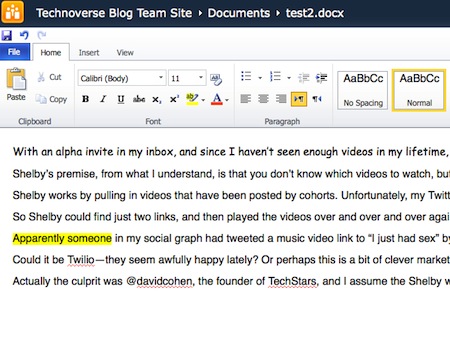I just received my beta invite to use Office 365, “the next generation in cloud productivity that brings together Microsoft Office, SharePoint Online, Exchange Online and Lync Online in an always-up-to-date cloud service.”
Imagine: all that Microsoft goodness now available on any browser!
Bloodied from confronting Microsoft Publisher, FrontPage, Word, SharePoint and Windows (3.0, 95, XP) in corporate battlefields, it was a great relief a few years ago to switch to Google Docs for my basic office needs and finding operating system happiness in Mac OS.
So I’m still traumatized to see a bare-bones version of Word now available (but without templates, styles, macros, tags and other Mr. Softie goodies) in Office 365, poised to give the willies to new generations.
Of course, this is not the way to view Office 365. It is Microsoft’s take on cloud computing for the business world.
And yes, unlike Google Docs and Gmail, businesses will pay: $6 (5.25 euros) per user/month for 25-and-under licenses. I’m well aware there’s an enterprise version of Google Apps (around $4 per user/month), but for small businesses the free version is likely all the document management they’ll need.
For a bit more money ($24 per user/month), larger companies can experience the joy of Office Professional Plus which includes telephony, social networking, IM, and other sexy stuff.

Microsoft Word in the cloud
It all has a businessy feel (“99.9% uptime guaranteed”). You create a domain for your company or team website, and then have access to SharePoint’s document sharing capabilities, along with some basic workflow (checking docs in and out and more involved flows through SharePoint Designer).
In my brief testing of Office 365, I’ve already noticed some very MS ways of doing business. With Google Docs, I can quickly view my Adobe PDFs within the Googley viewer by right clicking on the doc icon.
Microsoft’s approach to PDF? You download the thing and bring it up in your local reader. Thanks Ballmer.
Anyway, it will all be comfortable enough for sales, marketing, finance, and other departments at HQ.
The selling point for Office 365 is that corporate cube dwellers get quick browser access to their PowerPoints, rather than, say, logging in to the corporate VPN and using Citrix.
When IBM launched its first mainframe, the 360 in the 1960s, the company already had several different lines of computers—IBM 1400 series, IBM 7000 family. The IBM 360 was backward compatible with these smaller, special purpose computers while supporting complicated instruction sets for scientific and large-scale business computing.
In other words, 360 could run all the same apps on this giant, faster, and centralized electronic brain.
IBM did quite well with their circa 1960s cloud strategy.
Of course, IBM unlike Microsoft was blazing a trail at the time.
Related articles
- Microsoft’s Office 365 Hits Public Beta (nytimes.com)
- Microsoft Office 365 (microsoft.com)


